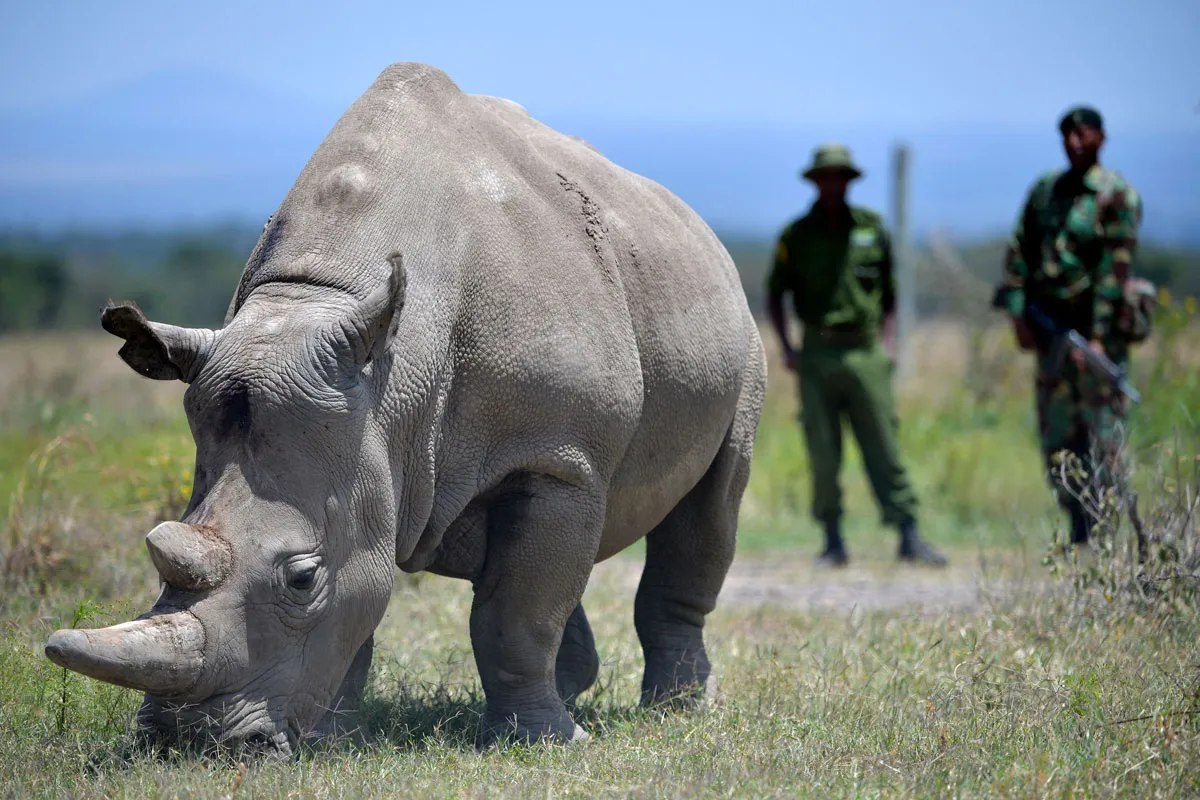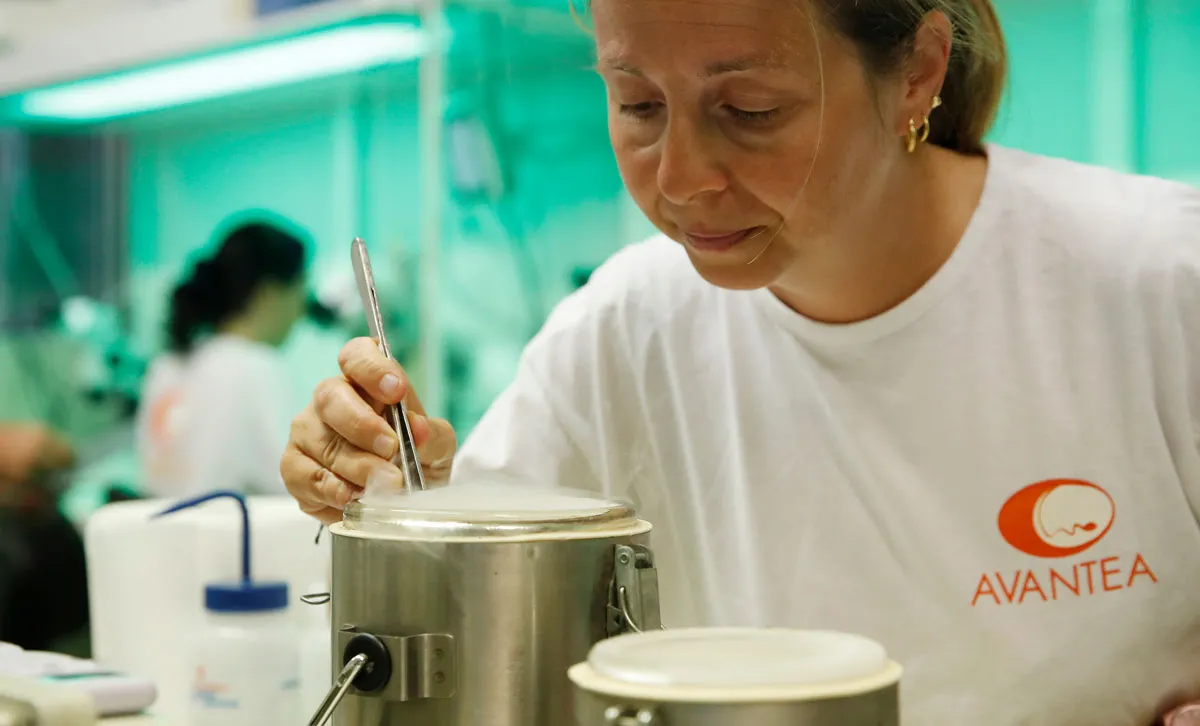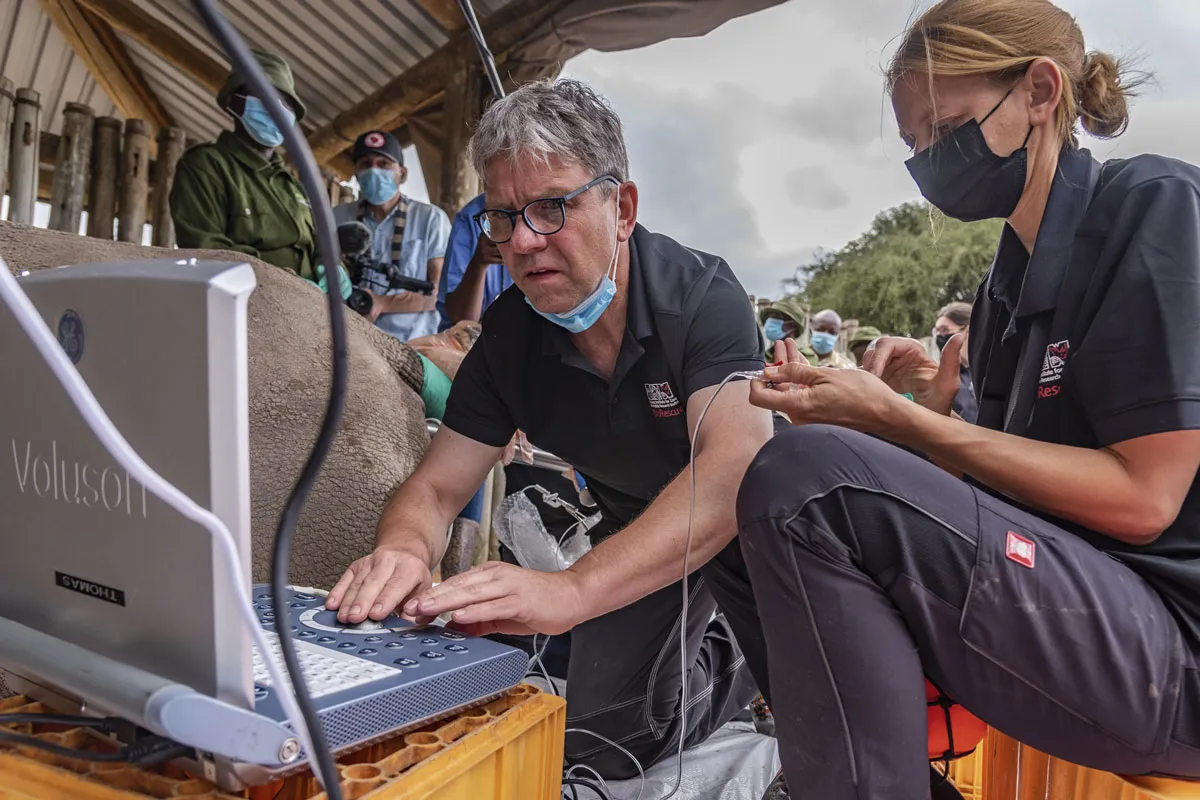It’s early morning in Kenya’s Ol Pejeta Conservancy, and under a wide African sky, the last two northern white rhinos left on Earth go for a stroll. From time to time, they pause; tasselled ears twitching, as they lower their broad, flat muzzles to nibble the parched grass.
Later in the day, as the mercury rises, they will retire to a shady spot and have a siesta, watched over by the armed guards who protect them from poachers around the clock.
The rhinos’ names are Najin and Fatu (see main image above), and they are mother and daughter. Neither can reproduce naturally, and even if they could, there are no males left for them to mate with.
This makes the northern white rhino as good as gone, or, as scientists would call it, ‘functionally extinct.’ Najin and Fatu are ‘dead rhinos walking.’
In decades gone by, this would have been the end of the line for the northern white rhino, but not anymore. For the last seven years, an international group of scientists have been working to bring this charismatic giant back from the brink.
The BioRescue project involves cutting-edge veterinary science, cell biology and the creation of ‘test tube rhinos’. If all goes according to plan, the pitter-patter of not-so-tiny rhino feet could be just a few years away.
“We have hope,” says veterinarian Prof Thomas Hildebrandt from the Leibniz Institute for Zoo and Wildlife Research, who is the project leader.
But the biggest challenge may not be in producing new rhinos, but the calming of critics who believe that the work should never go ahead in the first place.

Steep decline
At the start of the 20th Century, northern white rhinos were a common site on the savannahs of eastern and central Africa, but then poaching, habitat destruction and armed conflict caused populations to crash.
By the 1980s, there were just 15 animals left in the wild. When they died, conservationists hoped that the small number of animals left in captivity would be able to kickstart the population, but the rhinos didn’t get the memo. Northern white rhinos don’t breed well in captivity, and the last male, known as Sudan, died in 2018.
Gone but not forgotten, Sudan is just one of a number of northern white rhinos who may still be able to produce offspring from beyond the grave. Before the final few males died, Hildebrandt and colleagues started to collect and freeze their semen.
It’s a delicate procedure, performed under general anaesthesia, that sees a cylindrical probe guided up the animal’s rectum, before a few mild pulses of electricity are applied to stimulate the prostate gland.
Hildebrandt has developed and refined the method, so it can be performed quickly, painlessly and successfully. Now the team have semen samples stored away from four of the last male northern white rhinos, including Sudan.
Some of the samples were used to artificially inseminate Najin and Fatu, but when the females failed to become pregnant, the team turned their attention to in vitro fertilisation (IVF).
IVF involves the fusion of egg and sperm in a dish to create a ‘test tube embryo’, but rhino eggs are not easy to come by. Hildebrandt spent years devising a method to harvest them, working with females from other, more common, rhino species.
But by the time it was perfected, the only female northern white rhinos remaining were Najin and Fatu. Najin, however, is unable to donate eggs because she is elderly and has an ovarian tumour, which leaves 22-year-old Fatu as the only available donor.
Now Fatu undergoes the procedure roughly once every three months. Hildebrandt manoeuvres an ultrasound-guided needle a metre or so up her rectal passage, punctures through to the ovary, and then aspirates the immature eggs, known as oocytes.
“It’s quite stressful because we only have two hours to work whilst Fatu is asleep,” says Hildebrandt.
"Then, when the anaesthetic wears off, she’s back on her feet within minutes, none the worse for wear."
Hildebrandt and his team have successfully performed the procedure 11 times since 2019, and have collected 164 oocytes, but these are large cells that do not freeze or store well, so they need to be used fresh.
The oocytes are therefore flown to a specialist lab in Italy where they are matured in a bespoke cocktail of chemicals, and then used for IVF. Thawed sperm is injected directly into the egg, which then starts to divide to form an embryo.
This is the first part of the IVF procedure. Just like its human equivalent, it doesn’t always work and yet, the scientists have still managed to create 24 embryos, using eggs from Fatu and sperm from two different males.

While you can’t freeze oocytes, you can freeze early embryos, so for now these ‘test tube rhinos’ are frozen away in a vat of liquid nitrogen, waiting for the time when Hildebrandt is ready for the next stage: implanting the embryo into the uterus of a surrogate rhino mother. But which rhino to use?
Neither Najin nor Fatu are suitable surrogates. Najin’s back legs are too weak to carry a pregnancy, and although Fatu can produce oocytes, she has problems with her uterus. Fortunately, the northern white rhino has a close relative called the southern white rhino.
Listed as ‘near threatened’ by the International Union for the Conservation of Nature, there are around 16,000 southern white rhinos living in eastern and southern Africa, including 39 who live at Ol Pejeta.
Two of these have been earmarked by the conservancy as surrogates. Later this year, Hildebrandt and his team hope to fly to Kenya to implant one of their northern white embryos into one of these surrogates.
Rhino pregnancies last around 18 months, so if things go well, the first calf could be born as soon as 2024. Then, as more surrogates are recruited, more calves could follow, but there’s an elephant in the room.
Family matters
All of the northern white embryos created so far come from just three ‘parent’ animals; one female and two males. Any calves would be siblings or half-siblings. They would never be allowed to mate with each other for fear of inbreeding.
To make healthy, genetically diverse embryos, the scientists need more eggs and more sperm from other, non-related rhinos, and it’s here that some innovative cell biology comes in.
For more than 40 years, conservationists have been collecting and freezing living cells from all manner of endangered species. They’re an invaluable research resource, and increasingly a source of raw material for assisted reproductive technologies.
The ‘Frozen Zoo’, run by the San Diego Zoo Wildlife Alliance, contains over 70,000 samples from more than 700 species, including skin cells from 12 different northern white rhinos; eight unrelated individuals and four of their offspring.
Read more:
- Study of rhino's family tree could help save them from extinction
- Extinct woolly rhinos were a victim of climate change, not overhunting
In 2011, cell biologist Dr Jeanne Loring from the Scripps Research Institute, California, showed that these skin cells can be ‘reprogrammed’ to become stem cells.
Stem cells are versatile shape-shifting cells, with the potential to generate many other cell types. Then, in December 2022, a different group of researchers, this time from Japan, showed that these stem cells can be coaxed to become the precursors of egg and sperm.
Put simply, the research suggests that rhino eggs and sperm could be grown in the lab, using frozen, decades-old skin cells as the starting point. This means that when Fatu is retired as an oocyte donor, they will have other sources of oocytes. More research is needed to persuade these early egg and sperm cells to morph into their mature forms, but this really could be a game changer.
Loring points out that there is more genetic diversity in the 12 northern white rhino samples that are frozen away, than exists in the entire living population of southern white rhinos, who, she says, “are doing just fine.”

Scientists have the cells required to create a viable northern white rhino population, and increasingly, they have the methods required to make it happen.
The long-term goal is to reintroduce viable populations of northern white rhinos into the wild, where they would act as ecosystem engineers. By mowing the grass, African rhinos create the ‘grazing lawns’ on which species like impala and wildebeest depend. When the fires come, these closely-cropped patches act as natural firebreaks, providing safe havens for fire-intolerant plants and slow-moving animals.
Rhino dung returns nutrients to the ground. Their ticks provide food for birds, such as oxpeckers. When they wallow, they create and maintain waterholes.
Rhinos are remarkable animals that shape entire ecosystems. This is indisputable, and yet, not everyone is in favour of the northern white rhino’s return.
Let it go?
A key criticism of the BioRescue programme is that it’s too expensive, and that funding would be better spent protecting other rhino species, such as the black rhino in Africa or the Indian rhino in Asia.
These species are threatened, and their numbers are depleted, but not to the extent where they require assisted reproductive techniques to save them.
The BioRescue programme is unavoidably expensive. It’s primarily funded by the German science ministry, with a six-year grant approximating €6m (£5.25m approx), but Hildebrandt points out that the programme is not competing with other conservation missions, or diverting funds from them.
Another argument is that the project sets a dangerous precedent; that it’s okay to let species dwindle to the brink of extinction, because we can always bring them back later.
“But it’s not okay,” says Hildebrandt. “No one is advocating that."
“We need to be aware that this is something we cannot do routinely for each species, precisely because it is so costly.”
Others feel that the time has come to let nature run its course, and let the northern white rhino go. To do otherwise, they say, would be ‘playing God’.
“It’s an interesting argument,” says ethicist Prof Ronald Sandler from Northeastern University, Boston.
“It suggests that this is a place where our agency doesn’t belong, and speaks to a broader question about our role in the conservation context.”
He argues that traditional conservation methods, such as captive breeding, creating reserves and preventing poaching, are about undoing human impacts.
This work is not so different. The methods may be novel, but they’re still about undoing the damage that our species unleashed when it began to hunt and kill and the northern white rhino.
Read more:
- African Black Rhino numbers increasing thanks to 'immense' conservation efforts
- Back from the brink of extinction: The best conservation success stories
The final countdown
There’s one final argument, however, that is more difficult to counter.
The northern white rhino is Ceratotherium simum cottoni. The southern white rhino is Ceratotherium simum simum. They are not two separate species. They are separate subspecies, which is a term used to denote populations that are genetically similar but geographically distinct.
They went their own separate ways around 80,000 years ago when one population headed north, and another headed south.
They look ‘more or less’ the same, they behave ‘more or less’ the same, and genetically, they are ‘more or less’ the same.
The small differences that do exist may well turn out to be important, but in the absence of any scientific data to support this idea, why, some argue, waste resources saving the northern white rhino when it’s almost indistinguishable from its southern counterpart?
Ecologist Dr Jason Gilchrist from Edinburgh Napier University goes one step further. He’s worked in Africa, and has helped to relocate rhinos from dangerous to safe regions.
“Given the effort and cost needed to resurrect the northern white rhino, I think it would be more practical to translocate southern white rhinos into the areas where we’d like northern white rhinos to be, and then let natural selection do its job,” he says.
In time, he argues, evolution could delicately sculpt the southern white rhino into something that more closely resembles its northern relative.
It’s an option, but if conservation is in the business of saving species, shouldn’t it be in the business of saving subspecies too?
There’s another important reason why the work of Hildebrandt and colleagues is so very valuable. By perfecting their methods in one endangered species, it paves the way to do it in others.
Hildebrandt’s methods are already being employed to collect semen samples from other endangered mammals, including tigers and pandas. He’s working to perfect egg retrieval and embryo implants in elephants, while Loring has reprogrammed skin cells from an endangered African monkey species called the drill.
Meanwhile, Najin and Fatu are getting older. There are fewer than 76 Javan rhinos, and 50 Sumatran rhinos left in the wild. Hildebrandt believes these methods could help them, and other endangered species.
“Of course, we’d rather that they didn’t need this kind of intervention in the first place,” he says, “and yet, here we are.”
About our experts
Prof Thomas Hildebrandt heads the department of Reproduction Management at Leibniz Institute for Zoo and Wildlife Research. He is also honorary professorial fellow of life sciences at Melbourne University, a research associate of the Smithsonian Institution and a fellow of the Zoological Society of San Diego Zoo.
Prof Ronald Sandler is a professor of philosophy and Director of the Ethics Institute at Northeastern University. He teaches courses in moral philosophy and applied ethics, and has received Northeastern University’s Excellence in Teaching Award.
Dr Jason Gilchrist is a lecturer in the school of applied sciences at Edinburgh Napier University. His research has been published in journals including Ecology And Evolution and the Journal Of Biogeography.
Read more:
